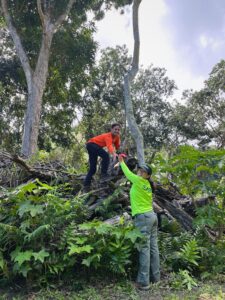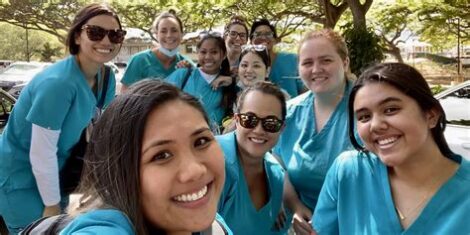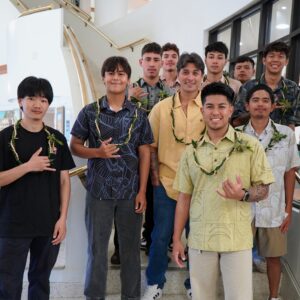The State of Aloha
It was a summer’s day when Pan American’s first commercial Boeing 707 jetliner landed at the Honolulu International Airport on Aug. 24, 1959 — a little more than a week after Hawaii became a state. The jet plane’s doors opened to let out a strange, new, phenomenon to the islands that is now very familiar to us: a drove of tourists from the Mainland.
So it began. Just days after entering the Union, Hawaii’s tourism industry hit its stride with the advent of jet travel. Before statehood, tourists to the islands tended to be wealthy. They were the few who could afford long trips by ocean liner and stay for days on end.
That changed with the jet plane. It was faster to get there and made Hawaii accessible for middle-class Americans. Today, tourism is the main engine for Hawaii’s economy. There’s little debate about that. It’s still the No. 1 industry. Nothing compares.
But that doesn’t mean we like it, which bothers folks in the industry. In a recent interview, the chief executive officer of Hawaiian Airlines, Mark Dunkerley, urged all of us in Hawaii to “examine our ambivalence toward tourism.”
Ambivalence is putting it politely. Since the late 1950s, generations of locals have grown up with the tourism industry. We have a love-hate relationship. Thousands of Hawaii residents are directly employed by hotels where droves of visitors stay for days and nights on end sipping cocktails, getting sunburned and, above all, spending money. We even have a special tax for hotel rooms and transient accommodations. What’s not to love?
We are constantly told that tourism is keeping our economy afloat. But that doesn’t mean it’s been all wine and roses for the islands. It can certainly be an obnoxious industry. The big-money tourism is resort-based tourism. Since the ’60s, Hawaii’s tourists are encouraged to isolate themselves in artificially constructed places like Waikiki, Kaanapali or Waikoloa. There, they stayed in a manufactured resort community with beaches, pools, restaurants and shops.
Interaction with local residents is limited to transactions of commerce. Tourists interacted largely among themselves. I always thought how obvious it was when you looked down at Waikiki from the air. It’s literally blocked in by the Ala Wai Canal.
This model is still in high demand. Look no further than Ko Olina on the leeward side of Oahu. The marina is home to a cluster of luxury resorts, including Disney’s Aulani Resort, a world-class hotel with beaches, golf courses and spa, where Disney characters regularly interact with tourists. Right next door is the site of another development, Atlantis Resorts and Residents Ko Olina, that will have an additional 800 hotel rooms and 524 high-end homes.
Then there’s the other kind of visitor, the ones who don’t think they’re tourists and rent houses in residential areas. These folks are in search of the authentic and look for it in our small towns and stores. (They’re still tourists.) Ironically, their quest for authenticity contributes to the housing crisis for local residents when housing units are converted to short-term vacation rentals.
So more tourists are on the rise. The numbers are already astounding. In 2016, 8.9 million tourists visited the islands. Last December alone saw 828,500 visitors — that’s more than half of the state’s population. In that month, tourists spent $1.7 billion.
Where is that money going? Back into infrastructure? For the folks on the ground, stuck in terrible traffic on outdated roadways and watching decaying public works pass by, it doesn’t seem like enough is being spent here.
Just down the road from Ko Olina is the Waianae Coast, where you can see how the rest of the leeward side looks, feels and lives. Homeless camps, high crime and poverty are typically associated with this part of the island.
Oahu isn’t the only place where you can find such a stark contrast. On Maui, we have resort communities in Kaanapali and Wailea, which stand apart from their grittier neighbors in Lahaina and Kihei. Should we really be excited about more tourists coming to the islands like the CEO of Hawaiian Airlines wants us to be?
No way. The Legislature recently presented a bill finding that “an ever increasing number of visitors can negatively impact the quality of life of Hawaii residents by straining the state’s infrastructure and natural resources.” The law would divert money away from marketing for more tourists and would help fund beach cleanups and trail maintenance. It never got a hearing before the Senate Ways and Means Committee and died.
The sentiment behind the bill is genuinely felt by many residents. Now that cane is gone from the islands forever, we look to our latest big-time industry, but like cane workers from generations ago, we may not like what we see.
* Ben Lowenthal is a trial and appellate lawyer, who grew up on Maui. His email is 808stateofaloha@gmail.com. “The State of Aloha” alternates Fridays with Sarah Ruppenthal’s “Neighbors.”




